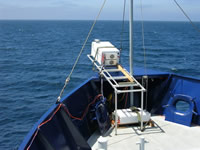


|
The Project
|
August 26, 2005
The warm sun is a refreshing change this afternoon after a morning of chilly gray fog. The fog has lifted and the sun is shining its brilliant light down on the entire bay. Today there is color everywhere. The soft light blue of the sky and the deep indigo blue of the sea mix with the bright whites of the wave crests and the sails of the nearby sailboats. The coastal landscape offers browns, reds and greens of the hillside farmland. The Capitola countryside makes a nice backdrop for the pink, turquoise, and terracotta colors of the beachside village. Light from the sun contains all the colors that you see in a rainbow. It is these colors that are absorbed, reflected or scattered to enable your eyes to see the colors of the world around you. Each color in the color spectrum has a different energy level or wavelength. Blue has the shortest wavelength and its color is scattered by the tiniest of particles in the clear sky. It is the scattered color that your eyes see. In the evening when the sun is low on the horizon, you are looking directly at the sun and there are many more particles that scatter the blue light away from your eyes. The blue light is scattered away as the reds and yellows are seen through the haze as beautiful sunsets. Light is used in many of the instruments that are being used by the science team on this research expedition. Jennifer and Brian work in the upper lab monitoring an instrument called a lidar (light detection and ranging). It is similar to the radar the police use to measure the speed and distance of a moving car. The lidar is contained in an aluminum box that is mounted on the bow of the ship. The box is painted a bright white so that it will reflect all light and therefore the box will stay cool. The lidar shines a very powerful laser beam of green light into the ocean. The green color of the laser was chosen because of its ability to penetrate the furthest in the blue/green/brown waters of the Monterey Bay. As the laser shines into the water some light is reflected by the surface of the water like light from a mirror, the remainder of the light enters the water and is absorbed and scattered by water and any particles in the water. The light scattered directly back up to the instrument is the light that is recorded. This back-scattered light is what gives the information needed by the scientists looking for thin layers of plankton. When the ship moves across a layer, the light scattered back to the instrument is intensified and change is very noticeable on the computer screen. Scientists in the lower lab are notified when layers are discovered so they can make more detailed observations and collect biological and chemical samples. Experiment: Use a flashlight to shine light on different types of surface areas inside a dimly lit room. The white light shining from your flashlight is made up of many colors. As you shine the light on different objects the light behaves different according to the properties of the material of the object. Some things absorb certain colors of light while scattering light from one color back to your eyes. Some things like glass, mirrors, and shiny objects reflect light back to your eyes so you see a glare. Try shining the light into a bucket of water. Write down you observations as you swirl and shake the bucket of water. A math problem relating to lidar:(use a calculator for this one) The speed of light is about 300,000,000 (three hundred million) meters per second in air. Since there are about 3.3 feet in every meter you can calculate the speed of light in feet per second (ft/sec) by multiplying. Now, this number is very large so most people convert it to miles by dividing by 5,280 feet (this is the number of feet in a mile). The speed of light in water is slower than it is in air. Multiply the speed of light in air by three quarters (3/4) to estimate the speed of light in water.
|


